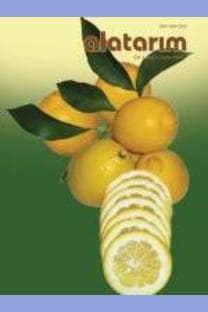Akito gül çeşidinde sıcaklığın çiçek kalitesi üzerine etkisi
Kontrollü koşullarda gerçekleştirilen topraksız gül yetiştiriciliğinde sıcaklık en etkili faktörlerden birisidir. Bu çalışmada,Akito gül çeşidinde 17-24°C arasındaki ortalama sıcaklık değerlerinin çiçek tomurcuğunun görülme tarihi, goncanın açılma derecesi, gözlerin uyanmasından hasat zamanına kadar geçen süre, gonca yaş ve kuru ağırlığı, gonca büyüklüğü üzerine etkileri araştırılmıştır. Sıcaklığın gonca büyüklüğünde etkili olduğu ve yüksek sıcaklıkta yetişen gül goncalarının düşük sıcaklıkta yetişen gül goncalarına göre daha küçük kaldığı saptanmış ve yaş ve kuru ağırlıkları da daha düşük olarak tespit edilmiştir. Yüksek sıcaklık gelişme periyodunu kısaltırken, düşük sıcaklık tam tersi etki yapmıştır.
The effect of temperature on flower quality of rose cultivar Akito
Temperature is one of the many factors claimed to have an impact on growth cycle of soilless cultured rose under greenhouse conditions. The influence of temperature in the range of 17-24 °C on visibility of flower bud, development time of shoot, flower opening stage and fresh and dry weight of flowers on the rose cultivar Akito was studied. The study found statistically significant relationship between temperature and flower stages indicates that, higher temperature resulted in smaller flower stages. A further analysis on fresh and dry weight of flower bud at the harvesting time also revealed that high temperature resulted in low fresh and dry flower bud weights. Higher temperatures resulted in a shortening of the growth cycle, while lower temperature led to the opposite.
___
- Brown W.W., Ormrod, D.P., 1980. Soil temperature effects on greenhouse roses in relation to air temperature and nutrition. J. Amer. Soc. Hort. Sci. 105(1): 57 - 59.
- De Jong, J., 1978. Dry storage and subsequent recovery of cut gerbera flowers, an aid in the selection for longevity. Scientia Hort. 9: 389-397.
- De Vries D.P., Smeets, L., 1979. Effects of temperature on growth and development of hybrid tea-rose seedlings. ScientiaHortic. 11: 261 - 268.
- De Vries D.P., Smeets, L., Dubois, Lidwien A.M., 1980. Genetic variation for the time of first flower and shoot length in hybrid tea-rose seedling populations under a range of temperatures. ScientiaHorti., 13: 61 - 66.
- De Vries D.P., Smeets, L., Dubois, Lidwien, A.M., 1982. Interaction of temperature and light on growth and development of hybrid tea-rose seedlings, with reference to breeding for low-energy requirements. ScientiaHorti., 17: 377 - 382.
- Karlsson, M.G., Heins, R.D., Erwin, J.E., Berghage, R.D., Carlson, W.H., Biernbaum, J.A., 1989. Irradiance and temperature effects on time of development and flower size in chrysanthemum. Scientica Horticulturae, vol. 39, issue 3, pages 257 - 267.
- Marcelis-van Acker, C.A.M., 1994. Axillary bud development in rose. Dissertation Agric. Univ. Wageningen, The Netherlands. 131pp.
- Marcelis-van Acker, C.A.M., 1995. Effect of temperature on development and growth potential of axillary buds in roses. Sci. Hortic.63: 251-261.
- Moe, R., Kristoffersen, T., 1969. The effect of temperature and light on growth and flowering of Rosa Baccara in greenhouses.ActaHortic. 14: 157 - 163.
- Moe R., 1972a. Effect of day length, light intensity, and temperature on growth and flowering in roses. J. Am. Soc. Hort. Sci. 97: 796 - 800.
- Moe, R., 1973. Propagation, growth and flowering of potted roses. Acta Hortic. 33: 35-50.
- Porter, J.R., Delecolle, R., 1988. Interaction of temperature with other environmental factors controlling the development of plants. In: Plants and temperature (S.P. Long & F.I. Woodward, eds). Symp. Soc. Exp. Biol. 42. Company of Biologists, Cambrige, pp. 133- 156.
- Van den Berg, G.A., 1987. Influence of temperature on bud-break, shoot growth, flower bud atropy and winter production of glasshouse roses. Dissertation Agric. Univ. Wageningen, 170pp.
- ISSN: 1304-2653
- Başlangıç: 2015
- Yayıncı: Alata Bahçe Kültürleri Araştırma Enstitüsü
Sayıdaki Diğer Makaleler
'Jiro' Trabzon hurması çeşidinde meyve tutumu ve kalitesi üzerine farklı tozlayıcıların etkisi
Ercan YILDIZ, Mustafa KAPLANKIRAN
Akito gül çeşidinde sıcaklığın çiçek kalitesi üzerine etkisi
Pembe ÇÜRÜK, Tolga İZGÜ, Yeşim MENDİ YALÇIN, Jan VOS, Ep HEUVELINK
Dünyada tarımsal Ar-Ge harcamaları ve Türkiye
Hülya YILDIRIM, SEVGİ PAYDAŞ KARGI, Şenay KARABIYIK
HASAN PINAR, Atilla ATA, Davut KELEŞ, Nedim MUTLU, MUSTAFA ÜNLÜ
Fuji elma çeşidinde salisilik asit uygulamalarının soğukta depolama süresince kaliteye olan etkileri
K. Ferhan SABIR, Fatma YİĞİT, Saliha TAŞKIN
'Jiro' Trabzon hurması çeşidinde meyve tutumu ve kalitesi üzerine farklı tozlayıcıların etkisi
